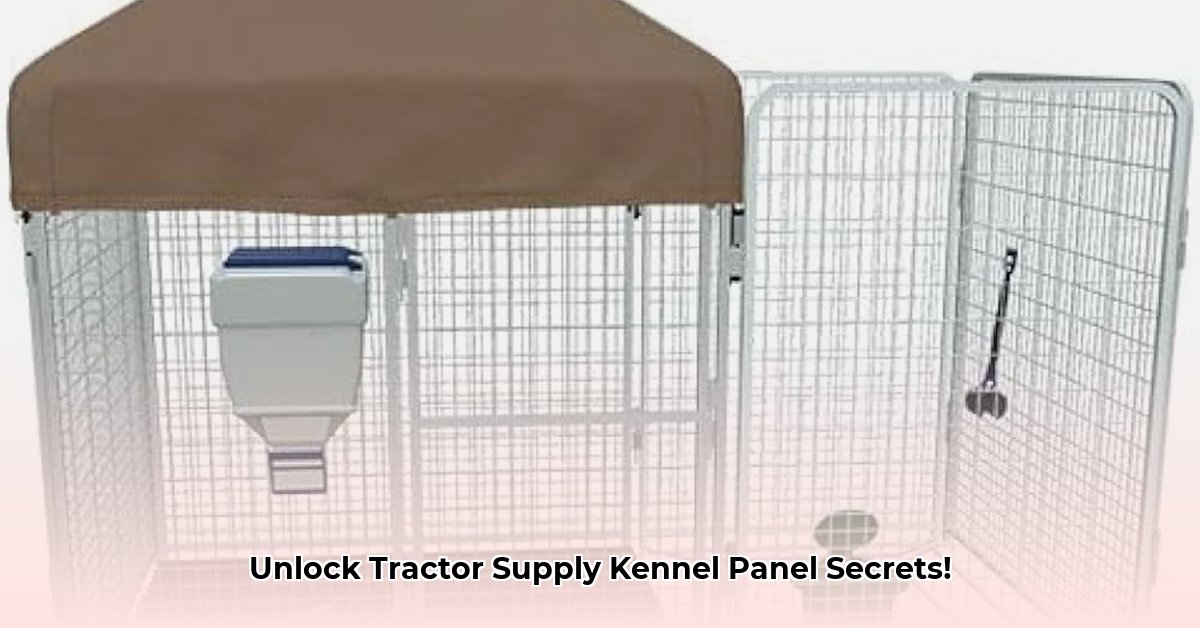
This guide explores the surprising versatility of Tractor Supply dog kennel panels, showcasing their potential beyond canine confinement. We'll explore creative repurposing for various on-farm applications, improving efficiency and sustainability. For more panel options, check out Tractor Supply Panel Options.
Planning Your Project: Before You Buy
Before heading to Tractor Supply, meticulous planning is crucial. Consider these factors:
- Project Scope: What will the panels be used for? (e.g., windbreak, small animal shelter, plant support structure) This dictates panel type and quantity needs.
- Panel Specifications: Choose the appropriate panel height, material (wire, plastic), and gauge for your specific application. Heavier-gauge panels offer greater durability. Consider wire mesh for air circulation or solid plastic panels for added weather resistance.
- Site Assessment: Assess the location carefully. Sunlight exposure, wind patterns, and soil conditions all affect your structure's design and stability. What is the existing infrastructure? Do you need to adapt to it in some way, and if so, how?
- Tools and Materials: Determine the necessary tools (e.g., wire cutters, pliers, zip ties, post-hole diggers) and any additional materials (e.g., concrete footings, wood supports, roofing materials). Do you want to attach hardware for easy disassembly?
Choosing Your Panels: A Tractor Supply Shopping List
Tractor Supply offers various dog kennel panels. Consider these factors to make an informed choice:
- Material: Wire panels are lightweight and provide good ventilation, suitable for temporary structures or applications where airflow is important. Plastic panels offer increased durability but might require additional support.
- Panel Size and Gauge: Taller panels are suitable for larger projects or areas needing greater protection. Heavier gauge wires or thicker plastic panels provide enhanced strength and longevity.
- Connectors: Examine the panel connectors; some panels feature integrated clips while others require additional fasteners or clamps. A reliable system simplifies assembly and increases structural integrity. For increased durability, consider welding wire panels instead of using only fasteners.
Building Your Structure: A Step-by-Step Guide
Once you have your panels, follow these steps to construct your chosen structure:
- Layout and Planning: Lay out the panels on the ground to visualize the final structure and ensure proper fit before attaching anything permanently. This also minimizes errors.
- Foundation Preparation: If needed, prepare a sturdy foundation. Concrete footings provide exceptional stability, while using existing structures as anchors will avoid extra labor.
- Panel Connection: Securely connect the panels using the appropriate fasteners or connectors. Ensure that each connection is tight and stable, avoiding weak points that would compromise the structure's integrity.
- Reinforcement: Use additional bracing or supports, such as wooden posts or metal brackets, to boost structural strength, particularly in areas exposed to high winds or significant weight.
- Additional Features: Add roofing, walls, or other features as needed, using durable materials that resist weather elements. Consider adding a base or ground cover. What additional features would enhance the project's functionality? These could include shelves, doors, or additional supports.
Repurposing Examples: Maximizing Panel Potential
Tractor Supply dog kennel panels have many on-farm uses beyond containing animals:
- Windbreaks: Create effective windbreaks to protect crops or livestock from harsh weather conditions. A well-placed windbreak can significantly minimize crop damage and improve livestock health.
- Small Animal Shelters: Construct simple, affordable shelters for rabbits, poultry, or other small animals, protecting them from predators and adverse weather.
- Plant Support Structures: Vertical structures can support climbing plants, increasing yield and efficient use of space. Trellising systems using these panels can be particularly effective for vining plants.
- Temporary Fencing: Create temporary dividers or enclosures in the field to manage livestock or separate plantings, keeping things neatly organized.
Maintenance and Longevity
Proper maintenance extends the life of your structure:
- Regular Inspections: Frequently inspect your structure for loose connections or damage. Tighten screws or replace damaged components immediately.
- Cleaning: Keep the structure clean and free of debris to maintain its structural integrity and prevent rust or decay. Cleaning should be done regularly, depending on the environment.
- Weather Protection: Consider applying a protective coating, like a weather-resistant sealant, to extend its lifespan and resistance to decay from the elements. This is crucial in harsh environments.
- Storage: If the structure is temporary, disassemble and store panels properly during periods of inactivity. Proper storage increases the lifespan of the panels.
Dr. Emily Carter, Professor of Agricultural Engineering, University of California, Davis, states: "Repurposing materials demonstrates resourceful sustainability. Careful planning ensures projects like this maximize both cost-effectiveness and longevity."
By following this guide, you can transform inexpensive dog kennel panels into versatile and useful structures on your farm, showcasing both resourcefulness and agricultural innovation.